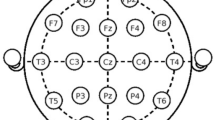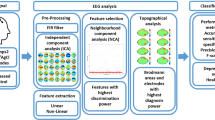Abstract
Electroencephalography (EEG)–based studies focus on depression recognition using data mining methods, while those on mild depression are yet in infancy, especially in effective monitoring and quantitative measure aspects. Aiming at mild depression recognition, this study proposed a computer-aided detection (CAD) system using convolutional neural network (ConvNet). However, the architecture of ConvNet derived by trial and error and the CAD system used in clinical practice should be built on the basis of the local database; we therefore applied transfer learning when constructing ConvNet architecture. We also focused on the role of different aspects of EEG, i.e., spectral, spatial, and temporal information, in the recognition of mild depression and found that the spectral information of EEG played a major role and the temporal information of EEG provided a statistically significant improvement to accuracy. The proposed system provided the accuracy of 85.62% for recognition of mild depression and normal controls with 24-fold cross-validation (the training and test sets are divided based on the subjects). Thus, the system can be clinically used for the objective, accurate, and rapid diagnosis of mild depression.

The EEG power of theta, alpha, and beta bands is calculated separately under trial-wise and frame-wise strategies and is organized into three input forms of deep neural networks: feature vector, images without electrode location (spatial information), and images with electrode location. The role of EEG’s spectral and spatial information in mild depression recognition is investigated through ConvNet, and the role of EEG’s temporal information is investigated using different architectures to aggregate temporal features from multiple frames. The ConvNet and models for aggregating temporal features are transferred from the state-of-the-art model in mental load classification.




Similar content being viewed by others
References
Brundtland GH (2001) Mental health: new understanding, new hope. Jama 286:2391–2391
Ibrahim AK, Kelly SJ, Adams CE, Glazebrook C (2013) A systematic review of studies of depression prevalence in university students. J Psychiatr Res 47:391–400
Othieno CJ, Okoth RO, Peltzer K, Pengpid S, Malla LO (2014) Depression among university students in Kenya: prevalence and sociodemographic correlates. J Affect Disord 165:120–125
Peltzer K, Pengpid S, Olowu S, Olasupo M (2013) Depression and associated factors among university students in Western Nigeria. J Psychol Afr 23:459–465
Ibrahim AK, Kelly SJ, Glazebrook C (2012) Analysis of an Egyptian study on the socioeconomic distribution of depressive symptoms among undergraduates. Soc Psychiatry Psychiatr Epidemiol 47:927–937
Asante KO, Andoh-Arthur J (2015) Prevalence and determinants of depressive symptoms among university students in Ghana. J Affect Disord 171:161–166
Volz H-P, Laux P (2000) Potential treatment for subthreshold and mild depression: a comparison of St. John’s wort extracts and fluoxetine. Compr Psychiatry 41:133–137
Hu B, Rao J, Li X, Cao T, Li J, Majoe D, Gutknecht J (2017) Emotion regulating attentional control abnormalities in major depressive disorder: an event-related potential study. Sci Rep 7(13530)
Jiang H, Hu B, Liu Z, Yan L, Wang T, Liu F, Kang H, Li X (2017) Investigation of different speech types and emotions for detecting depression using different classifiers. Speech Comm 90:39–46
Li X, Cao T, Sun S, Hu B, Ratcliffe M (2016) Classification study on eye movement data: towards a new approach in depression detection. In: Evolutionary Computation (CEC), IEEE Congress on. IEEE, pp 1227–1232. https://doi.org/10.1109/CEC.2016.7743927
Lu S, Xu J, Li M, Xue J, Lu X, Feng L, Fu B, Wang G, Zhong N, Hu B (2017) Attentional bias scores in patients with depression and effects of age: a controlled, eye-tracking study. J Int Med Res 45:1518–1527
Li X, Hu B, Sun S, Cai H (2016) EEG-based mild depressive detection using feature selection methods and classifiers. Comput Methods Prog Biomed 136:151–161
Li P, Song X, Wang J, Zhou X, Li J, Lin F, Hu Z, Zhang X, Cui H, Wang W (2015) Reduced sensitivity to neutral feedback versus negative feedback in subjects with mild depression: evidence from event-related potentials study. Brain Cogn 100:15–20
Akar SA, Kara S, Agambayev S, Bilgiç V (2015) Nonlinear analysis of EEGs of patients with major depression during different emotional states. Comput Biol Med 67:49–60
Acharya UR, Sudarshan VK, Adeli H, Santhosh J, Koh JE, Puthankatti SD, Adeli A (2015) A novel depression diagnosis index using nonlinear features in EEG signals. Eur Neurol 74:79–83
Acharya UR, Sudarshan VK, Adeli H, Santhosh J, Koh JE, Adeli A (2015) Computer-aided diagnosis of depression using EEG signals. Eur Neurol 73:329–336
Sharma M, Achuth P, Deb D, Puthankattil SD, Acharya UR (2018) An automated diagnosis of depression using three-channel bandwidth-duration localized wavelet filter bank with EEG signals. Cogn Syst Res 52:508–520
Cai H, Han J, Chen Y, Sha X, Wang Z, Hu B, Yang J, Feng L, Ding Z, Chen Y (2018) A pervasive approach to EEG-based depression detection. Complexity 2018:1–13
Zhang X, Hu B, Zhou L, Moore P, Chen J2012 An EEG based pervasive depression detection for females. In: Joint International Conference on Pervasive Computing and the Networked World, Springer, pp 848–861
Liao S-C, Wu C-T, Huang H-C, Cheng W-T, Liu Y-H (2017) Major depression detection from EEG signals using kernel eigen-filter-bank common spatial patterns. Sensors 17:1385
Hosseinifard B, Moradi MH, Rostami R (2011) Classifying depression patients and normal subjects using machine learning techniques. In: Electrical Engineering (ICEE),19th Iranian Conference on, 2011. IEEE, pp 1–4
Hosseinifard B, Moradi MH, Rostami R (2013) Classifying depression patients and normal subjects using machine learning techniques and nonlinear features from EEG signal. Comput Methods Prog Biomed 109:339–345
Hinton GE, Srivastava N, Krizhevsky A, Sutskever I, Salakhutdinov RR (2012) Improving neural networks by preventing co-adaptation of feature detectors. arXiv preprint arXiv:12070580.
Karpathy A, Toderici G, Shetty S, Leung T, Sukthankar R, Fei-Fei L (2014) Large-scale video classification with convolutional neural networks. In: Proc IEEE Conf Comput Vis Pattern Recognit, pp 1725–1732
Zhang X, LeCun Y (2015) Text understanding from scratch. arXiv preprint arXiv:150201710
Schirrmeister RT, Springenberg JT, Fiederer LDJ, Glasstetter M, Eggensperger K, Tangermann M, Hutter F, Burgard W, Ball T (2017) Deep learning with convolutional neural networks for brain mapping and decoding of movement-related information from the human EEG. arXiv preprint arXiv:170305051.
Acharya UR, Oh SL, Hagiwara Y, Tan JH, Adeli H, Subha DP (2018) Automated EEG-based screening of depression using deep convolutional neural network. Comput Methods Prog Biomed 161:103–113
Tripathi S, Acharya S, Sharma RD, Mittal S, Bhattacharya S (2017) Using deep and convolutional neural networks for accurate emotion classification on DEAP dataset. In: AAAI, . pp 4746–4752
Tabar YR, Halici U (2016) A novel deep learning approach for classification of EEG motor imagery signals. J Neural Eng 14:016003
Güler NF, Übeyli ED, Güler I (2005) Recurrent neural networks employing Lyapunov exponents for EEG signals classification. Expert Syst Appl 29:506–514
Pan SJ, Yang Q (2010) A survey on transfer learning. IEEE Trans Knowl Data Eng 22:1345–1359
Zhang W, Li R, Zeng T, Sun Q, Kumar S, Ye J, Ji S (2016) Deep model based transfer and multi-task learning for biological image analysis. IEEE Trans Big Data
Bashivan P, Rish I, Yeasin M, Codella N (2015) Learning representations from EEG with deep recurrent-convolutional neural networks. arXiv preprint arXiv:151106448
Arslan MT, Eraldemir SG, Yıldırım E (2017) Subject-dependent and subject-independent classification of mental arithmetic and silent Reading tasks. Uluslararası Mühendislik Araştırma ve Geliştirme Dergisi 9:186–195
Mumtaz W, Xia L, Ali SSA, Yasin MAM, Hussain M, Malik AS (2017) Electroencephalogram (EEG)-based computer-aided technique to diagnose major depressive disorder (MDD). Biomed Signal Process Control 31:108–115
Li X, Hu B, Shen J, Xu T, Retcliffe M (2015) Mild depression detection of college students: an EEG-based solution with free viewing tasks. J Med Syst 39(187):187
Grin-Yatsenko VA, Baas I, Ponomarev VA, Kropotov JD (2010) Independent component approach to the analysis of EEG recordings at early stages of depressive disorders. Clin Neurophysiol 121:281–289
Alfeld P (1984) A trivariate clough—tocher scheme for tetrahedral data. Comput Aided Geom Design 1:169–181
Glorot X, Bordes A, Bengio Y (2011) Deep sparse rectifier neural networks. In: Proceedings of the fourteenth international conference on artificial intelligence and statistics, pp 315–323
Glorot X, Bengio Y (2010) Understanding the difficulty of training deep feedforward neural networks. In: Proceedings of the thirteenth international conference on artificial intelligence and statistics, pp 249–256
Kingma DP, Ba J Adam: (2014) A method for stochastic optimization. arXiv preprint arXiv:14126980.
Krizhevsky A, Sutskever I, Hinton GE (2012). Imagenet classification with deep convolutional neural networks. In: Advances in neural information processing systems, pp 1097–1105
Plis SM, Hjelm DR, Salakhutdinov R, Allen EA, Bockholt HJ, Long JD, Johnson HJ, Paulsen JS, Turner JA, Calhoun VD (2014) Deep learning for neuroimaging: a validation study. Front Neurosci 8(229)
Beck AT, Steer RA, Ball R, Ranieri WF (1996) Comparison of Beck depression inventories-IA and-II in psychiatric outpatients. J Pers Assess 67:588–597
Gong X, Huang Y-X, Wang Y, Luo Y-J Revision of the Chinese facial affective picture system. Chin Ment Health J 2011
Ferree TC, Luu P, Russell GS, Tucker DM (2001) Scalp electrode impedance, infection risk, and EEG data quality. Clin Neurophysiol 112:536–544
Vigário RN (1997) Extraction of ocular artefacts from EEG using independent component analysis. Electroencephalogr Clin Neurophysiol 103:395–404
Hu B, Majoe D, Ratcliffe M, Qi Y, Zhao Q, Peng H, Fan D, Zheng F, Jackson M, Moore P (2011) EEG-based cognitive interfaces for ubiquitous applications: developments and challenges. IEEE Intell Syst 26:46–53
Witten IH, Frank E, Trigg LE, Hall MA, Holmes G, Cunningham SJ (1999) Weka: Practical machine learning tools and techniques with Java implementations.
Leppänen JM, Milders M, Bell JS, Terriere E, Hietanen JK (2004) Depression biases the recognition of emotionally neutral faces. Psychiatry Res 128:123–133
Thomas KM, Drevets WC, Whalen PJ, Eccard CH, Dahl RE, Ryan ND, Casey B (2001) Amygdala response to facial expressions in children and adults. Biol Psychiatry 49:309–316
Cecotti H, Graser A (2011) Convolutional neural networks for P300 detection with application to brain-computer interfaces. IEEE Trans Pattern Anal Mach Intell 33:433–445
Knott V, Mahoney C, Kennedy S, Evans K (2001) EEG power, frequency, asymmetry and coherence in male depression. Psychiatry Res Neuroimaging 106:123–140
Funding
This work was supported by the National Basic Research Program of China (973 Program) [No. 2014CB744600], the National Natural Science Foundation of China [Grant No. 61632014, No. 61210010, and No. 61402211], the Fundamental Research Funds for the Central Universities [No. lzujbky-2017-it74 and No. lzujbky-2017-it75], the International Cooperation Project of Ministry of Science and Technology [No. 2013DFA11140], and the Program of Beijing Municipal Science & Technology Commission [No. Z171100000117005].
Author information
Authors and Affiliations
Corresponding author
Ethics declarations
Conflict of interest
The authors declare that they have no conflict of interest.
Ethical approval
All procedures performed in studies involving human participants were in accordance with the ethical standards of the institutional and/or national research committee and with the 1964 Helsinki declaration and its later amendments or comparable ethical standards.
Informed consent
Informed consent was obtained from all individual participants included in the study.
Additional information
Publisher’s note
Springer Nature remains neutral with regard to jurisdictional claims in published maps and institutional affiliations.
Rights and permissions
About this article
Cite this article
Li, X., La, R., Wang, Y. et al. EEG-based mild depression recognition using convolutional neural network. Med Biol Eng Comput 57, 1341–1352 (2019). https://doi.org/10.1007/s11517-019-01959-2
Received:
Accepted:
Published:
Issue Date:
DOI: https://doi.org/10.1007/s11517-019-01959-2




